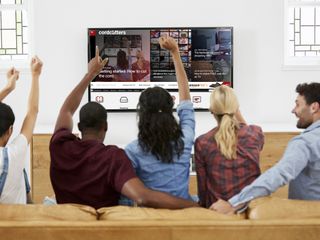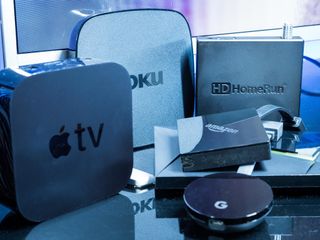The CordCutters guide to cutting the cord
This is how we get rid of cable and satellite TV

We'll never truly be rid of cords and cables. So long as we have things that need electricity and data, we'll need cords and cables. But consuming content — movies and shows and music and all things streaming — in 2018 is far different than when cable TV came of age some 30 years ago.
We have more options than ever before. That's both in terms of what it is we want to watch, but also options for how we're going to watch. Just like the newspaper and the telephone, traditional cable TV isn't going anywhere anytime soon. But it is evolving. And while many of us still rely on a cable provider for internet access, no longer is it the sole source (never mind satellite) for entertainment.
We can use that to our advantage. We can watch more of what we want to watch. And we can save money in the process. The hardware. The software. The services and subscriptions. We'll walk you through what you need to know before you cut the cord, and how to make the most of it once you've done the deed.
- What is cutting the cord?
- Why cut the cord?
- What hardware do you need?
- What services do you need?
- What accessories do you need?
What is cutting the cord?
"Cutting the cord" is a bit of a misnomer. (And inevitably someone in the comments will chime in with "that's not really cutting the cord." Thanks. That's helpful.) What we call "cutting the cord," or "cable cutting" really just means trading traditional cable TV — and more importantly the taxes and fees that go with it — with … something else.
For the most part when you talk about "cutting the cord" you're talking about moving to some sort of "streaming" service. And all that really means is you're watching digital video through an internet connection instead of through a cable box. What's the difference? Mostly ease of use. But also price. Very much price.
Are we really getting rid of cables and cords? Nope. In fact, you'll quite possibly end up with more cords. But that's not really the point of all this.
No. The point is …
Get the What to Watch Newsletter
The latest updates, reviews and unmissable series to watch and more!
Why cut the cord?
Cable TV can be expensive these days. Between the packages of content — and often with loads of channels that you'll never watch — and hardware rentals and the taxes and fees that go along with it all, it can get really expensive. Even more so if you live in a town without any real choices between cable providers.
It's all about saving a little money. Or a lot of money.
But cable TV also is pretty simple. One box. One remote control. That's it. So why rock the boat?
Money. It always comes down to money. It's entirely possible to watch as much — or even more — through streaming services and and actually save money in the process. It's all about finally being able to get what you want, without too much extraneous fluff, and without paying too much for it.
There's no single equation for this. What I want to watch and what I want to spend every month will be different from what you want to watch and what you want to spend. But, again, that's the point. It's about you and your needs.

What you'll need to cut the cord
OK. So you've decided to get rid of that cable box — which ingests digital signals and translates them into something you can watch — and replace it it … something else that ingests digital signals and translates them into something you can watch. (See what we mean about how you're not actually cutting the cord?)
There's a decent chance you already own some cord-cutting hardware.
We can divide all of this into two necessary categories. You'll need some hardware — something with which you can watch all this streaming content. And you'll need some sort of service that'll actually "stream" it all to you in the first place.
The hardware can come in a couple forms. The majority of displays sold today — particularly those sold by major manufacturers such as Vizio, Samsung, LG and TCL — have some sort of "smart" functionality. That is, they can connect to the internet and run applications of some sort, giving you access to streamed shows. Maybe the display is running some sort of proprietary (more or less) operating system, such as Samsung's Tizen or, or LG's webOS. Or maybe they're running the Roku software, or Amazon's Fire OS software, or Google's Android TV.
Or, you can use some sort of external box. Apple TV , Android TV , Amazon Fire TV , Roku — that sort of thing.
Read: The Cord-Cutter's Guide to Streaming Hardware
There are advantages and disadvantages to both schemes, but you'll need one or the other if you're cutting the cord and want to keep watching the same depth of content you were before.
And then there's over-the-air television. That's right, it's still possible in the 21st Century to erect an antenna, plug it in, and watch TV, free of any and all subscriptions. And, yes, the ability to record shows is still a thing.
Read: The Cord-Cutter's Guide to Free OTA TV
More: The best OTA antennas
Cutting the cord with streaming services
Hardware without software is just a brick. So you'll need some sort of streaming service with which you can watch shows. Most of the networks have their own individual apps and subscriptions, if that's how you want to roll. But that's pretty discombobulated, and it's not exactly realistic unless you watch only a scant few shows.
Live streaming services overlap a lot. Take advantage of the free trials and find what works best for you!
No, you'll most likely end up with a few services. And chances are you have a few already. Netflix, Amazon Video and Hulu are three of the major standalone services. They're also what you'd call online video distribution services. They bring the content directly to you.
There also are "multichannel video programming distributors" — a mouthful of words that really means one app for lots of channels. Sort of like old-school cable TV. Loads of channels, different options for packages (and different prices for each), and menus tying it all together.
It's all a not-that-weird mix of live content — yes, you can watch new episodes of Game of Thrones or Mr. Robot over a streaming service like Sling or PlayStation Vue or DirecTV or YouTube TV, right alongside your cable TV-loving neighbor. The difference? No contracts, often lower prices, and the possible occasional hiccups because streaming video still uses a lot of data, and the internet itself is still adjusting to that a bit.
Read: The Cord-Cutter's Guide to Streaming Services
See which channels are available on which services
Accessories for cutting the cord
A display and a streaming box are just the bare bones, of course. You can do more. You can do so much more. Because streaming TV over the internet instead of through a cable box doesn't mean you have to have a lesser experience. And that pretty much everything ties into the internet one way or another at this point means you can do all sorts of fun things.
There's the usual home entertainment stuff, of course. Surround-sound speakers are easy. Or you can rig up a whole-home solution like Sonos. Or just do a simple connected soundbar.
What about ambiance? A few strategically placed connected lights — like something from Philips Hue, perhaps — can make your viewing experience that much more fun — and it's even possible to sync up lights with what you're watching.
Or there's the old universal remote control. And this is one area I'd definitely recommend spending a little money. Because there's nothing worse than bad remote control — except maybe needing a few bad remote controls just to watch a movie. Better to get one device that does all the things.
More: Cord-cutting accessories you need to own
Cutting the cord — you can do this
This is your high-level guide for cutting the cord. For getting rid of cable TV and replacing it with something that's more customizable, and quite possibly less taxing on your wallet.
The links in this post and the features on this site will guide you on your way. It's an ever-changing process. Prices will fluctuate. Channels will come and go. New hardware is always being announced. We'll keep up with it so you don't have to.
All you have to do is keep up with us.
